Comprehensive Guide to Gardening Netting for Success
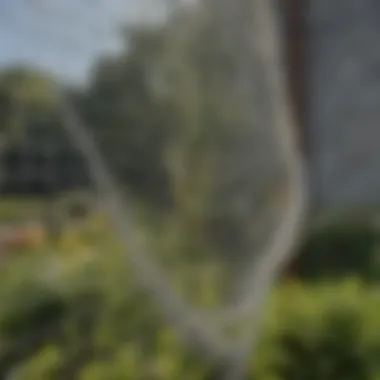
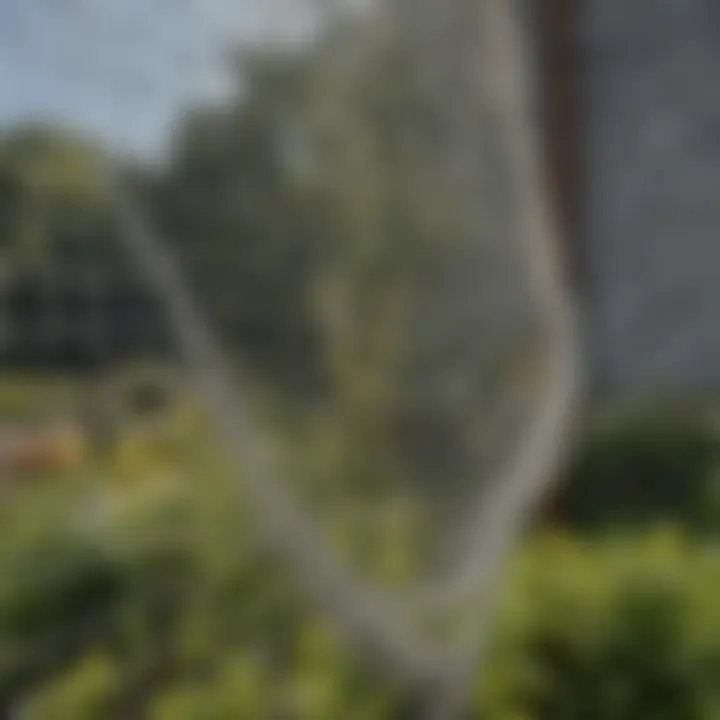
Intro
Gardening is an engaging pursuit that allows individuals to connect with nature and produce their own food. However, it comes with challenges, particularly the threat posed by pests and diseases. One effective solution is the use of gardening netting. This guide aims to delve into the subject, providing crucial information on various types of netting, their applications, and best practices for maintenance and implementation.
Key Concepts and Terminology
Basic Definitions
Understanding garden netting begins with grasping basic terms.
- Gardening Netting: A physical barrier made from fine mesh material designed to protect plants from pests.
- Pest Control: Methods employed to manage and reduce the impact of harmful insects and animals in the garden.
- Crop Yield: The amount of produce harvested from a given area.
These terms serve as the foundation for exploring the intricacies of gardening netting.
Historical Context
The use of netting in agriculture dates back several centuries. Initially made from organic materials, such as twine or woven fibers, farmers sought innovative ways to safeguard their crops from avian pests. As technology evolved, netting materials improved significantly, incorporating synthetic options that offer increased durability and effectiveness.
Recent Innovations and Trends
Technological Advancements
Recent years have seen notable developments in gardening netting. Manufacturers now offer netting that is both lightweight and strong, resistant to UV rays, and capable of withstanding various weather conditions. Innovations, such as anti-UV treatments, enhance the lifespan of netting.
Sustainable Practices
Sustainability plays an important role in modern gardening. Many gardeners now opt for biodegradable or recyclable netting, ensuring they make eco-friendly choices. This shift mirrors a broader trend within agriculture to prioritize methods that protect the environment.
Practical Applications and Techniques
Step-by-step Guides
- Choosing the Right Netting: Assess your specific gardening needs. Consider plant type, local pests, and growing conditions. Common options include insect mesh, bird netting, and shade cloth.
- Installation Process: Secure your netting over the garden beds. Ensure it is taut and well-anchored to prevent pests from accessing the plants.
- Maintenance Tips: Regularly inspect for tears or signs of deterioration. Clean the netting after severe weather to maintain its effectiveness.
Case Studies
Understanding real-world applications can be enlightening. For instance, a community garden in Seattle implemented bird netting and reported a significant reduction in avian visits. As a result, local produce yields increased by 25%. Such examples underscore the practical benefits of using gardening netting.
"Effective pest control through gardening netting can dramatically improve crop health and yield."
In summary, gardening netting proves to be a valuable tool for farmers and gardening enthusiasts alike. With the right knowledge and practices, individuals can protect their plants and promote healthier harvests.
Prelims to Gardening Netting
Gardening netting plays a crucial role in modern gardening practices. Its primary function is to protect plants from various external threats, ensuring that crops thrive in healthy conditions. The importance of gardening netting lies not only in its protective capabilities but also in its versatility. Enthusiasts and farmers alike benefit from its uses, ranging from pest control to frost protection, making it an essential tool in any gardening arsenal.
Every gardener faces challenges. Insects, birds, and harsh weather can impede growth and reduce yield. Gardening netting offers a tangible solution to these issues. With the right type of netting, gardeners can safeguard their plants, allowing them to flourish without interference. This is particularly valuable in organic gardening, where chemical interventions are limited.
In this article, we will explore the various types of gardening netting, their applications, and the unique advantages they provide. The aim is to give insight into how to select suitable netting based on specific gardening needs. We will also discuss important maintenance practices to ensure longevity and effectiveness of the netting materials.
Definition and Purpose
Gardening netting refers to a variety of fabrics or materials employed to cover or enclose plants. Its purpose extends to protecting plants from birds, insects, and adverse weather conditions, such as frost and excessive sunlight. The mesh openings in netting allow for sunlight and rain to penetrate while keeping harmful entities at bay.
Common types include bird netting, which prevents avian interference, and insect netting, which deters pests from feeding on crops. Each type serves a distinct protective function, contributing significantly to the health and growth of plants. When strategically implemented, gardening netting enhances not just protection but also yield, empowering gardeners to achieve their goals with more efficiency.
Historical Context
The use of netting in agriculture has roots dating back to ancient civilizations. Historically, farmers have utilized various materials such as fabric, twine, and even animal bones to shield their crops from unwanted wildlife and elements. With the continuous advancement of materials, gardening netting has evolved from rudimentary barriers to specialized netting designed for specific challenges.
In the last century, synthetic materials like nylon and polyethylene revolutionized gardening netting, making it more durable and accessible. These advancements have enabled gardeners to utilize netting in diverse climates and conditions. The shift towards sustainable practices also highlights a growing emphasis on organic gardening, where netting is increasingly employed as a non-chemical pest deterrent. Understanding this context is vital to appreciating the modern applications of gardening netting and its influence on contemporary gardening practices.
"Gardening netting serves as a simple yet effective barrier, fulfilling the dual role of protection and support in various gardening environments."
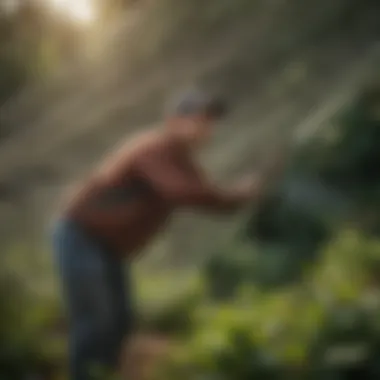

The following sections will delve deeper into specific types, advantages, installation, and maintenance of gardening netting, providing a comprehensive overview for both new and experienced gardeners.
Types of Gardening Netting
Understanding the various types of gardening netting is essential for effective gardening practices. Each type of netting serves a specific purpose, allowing gardeners to implement suitable solutions tailored to their needs. Selecting the right netting type not only enhances the health of plants but also maximizes crop yields. This section covers five principal types of gardening netting, including their unique characteristics and applications.
Bird Netting
Bird netting is primarily designed to prevent birds from accessing fruits, vegetables, and other crops. This type of netting is lightweight and typically made from polyethylene or nylon. Its mesh design allows sunlight and rain to pass through while blocking birds from landing on or pecking at plants.
When installing bird netting, it’s crucial to consider several factors:
- Mesh Size: Choose a mesh size that can effectively deter not just birds, but also small critters. Smaller openings are more effective for bird-proofing.
- Height and Coverage: Ensure that netting covers the full height of your crops, especially if you grow taller plants.
- Support Settings: Use frames or stakes to hold the netting off the plants, preventing contact that may damage foliage.
Insect Netting
Insect netting is specifically designed to protect plants from a variety of insects, including aphids, beetles, and caterpillars. This netting is usually made from fine woven mesh that keeps out unwanted pests while allowing beneficial insects and pollinators to enter.
Important considerations when using insect netting include:
- Durability: Ensure that the netting can withstand various weather conditions without tearing or degrading.
- Ease of Installation: Look for netting that can be easily put in place and taken down as needed.
- Compatibility with Your Garden: Consider the types of plants you are protecting, as some netting may not be suitable for certain foliage.
Garden Frost Protection Netting
Frost protection netting serves to insulate plants against cold temperatures and frost damage. This type of netting helps maintain warmer air around plants during chilly nights. It is often made from lightweight, breathable materials that allow moisture and sunlight to penetrate while providing necessary warmth.
When selecting frost protection netting, consider:
- Thickness: Thicker netting may provide better insulation but can block sunlight.
- Ease of Removal: Since frost events can be unpredictable, choose netting that is easy to remove during daytime.
- Reusability: Quality netting can last several seasons, making it a cost-effective option.
Shade Netting
Shade netting is utilized to reduce sunlight exposure to plants, particularly in hot climates. It shields plants from excessive heat and UV radiation. This netting comes in various degrees of shading, typically quantified by percentages such as 30%, 50%, or 70%.
Key factors to keep in mind include:
- Shade Percentage: Choose the appropriate level of shading based on the specific needs of your plants, as some require more light than others.
- Installation: Securely install shade netting to minimize flapping or movement, particularly in windy conditions.
- Material Quality: Look for netting made from durable, UV-resistant materials to ensure longevity.
Heavy-Duty Netting
Heavy-duty netting is built to withstand harsh weather conditions and prevent damage from larger animals, such as deer and raccoons. This netting is particularly strong and often made from robust materials like polypropylene or other resilient plastics.
When considering heavy-duty netting, pay attention to:
- Material Strength: The netting should be thick enough to resist tearing and withstand strong winds.
- Long-Term Use: Since this type of netting is typically intended for prolonged exposure, confirm its UV resistance and durability.
- Installation Requirements: Heavy-duty netting may need specific hardware for secure installation, such as stakes or frames.
Understanding these types of gardening netting allows you to make informed choices that will enhance your garden’s efficiency and productivity.
Benefits of Using Gardening Netting
Gardening netting serves various functions that enhance plant health and yield. Understanding these benefits can help gardeners make informed decisions. Effective use of gardening netting prevents common issues that affect plant growth, leading to better results overall. Here are several specific advantages:
Pest Control
One of the primary uses of gardening netting is pest control. Netting effectively protects plants from insects such as aphids, cabbage worms, and beetles. By physically blocking pests, netting reduces the need for chemical pesticides. This is not only beneficial for the environment but also for maintaining the health of edible plants. Furthermore, gardeners can tailor the type of netting used depending on the pests prevalent in their region, ensuring a more targeted approach.
Protection from Weather Extremes
Gardening netting also offers protection from harsh weather conditions. For instance, frost protection netting can prevent damage to sensitive plants during cold snaps. Similarly, shade netting can provide relief during peak summer months, helping to keep plants from wilting under excessive sun exposure. This advantage becomes increasingly crucial as climate fluctuations become more common. By utilizing appropriate netting, gardeners can enhance the resilience of their plants against unpredictable weather patterns.
Support for Climbing Plants
Support for climbing plants is another significant benefit of gardening netting. Vertical gardening techniques have gained popularity, and netting provides an effective structure for plants like peas, cucumbers, and beans to climb. This setup not only maximizes available space but also promotes better air circulation and light exposure. By encouraging vertical growth, netting can contribute to a more productive garden. Additionally, the arrangement helps minimize soil-borne diseases by keeping plants elevated and reducing contact with the ground.
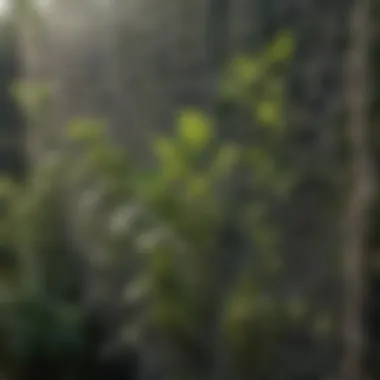

Netting is a crucial component of modern gardening strategies, offering multiple advantages that enhance plant health.
In summary, the use of gardening netting facilitates pest control, protects plants from weather extremes, and supports climbing varieties. Each benefit plays a vital role in promoting optimal growth and health for various types of plants. Gardeners should consider these factors when integrating netting into their gardening practices.
Selection Criteria for Gardening Netting
Choosing the right gardening netting is essential for achieving optimal results in your gardening endeavors. The selection criteria for gardening netting encompass various considerations that impact performance and effectiveness. Understanding these criteria helps in making informed decisions, ensuring the chosen netting meets the specific needs of your garden. Here, we delve into key elements to consider, which include material considerations, mesh size, and durability.
Installation Techniques
Proper installation of gardening netting is crucial for maximizing its effectiveness. The right techniques can significantly enhance pest protection, support plant growth, and ensure durability against various weather conditions. When undertaken correctly, these procedures can help gardeners avoid common pitfalls related to netting usage, such as sagging, tearing, or inadequate coverage.
Planning the Layout
Before putting up netting, consider the layout of your garden area. This step is essential to determine how much netting you will need and where to position it for optimal performance. Assess your garden's specific requirements. For example, are you protecting rows of vegetables, fruit trees, or flower beds? Each type may need a different approach.
- Measure the dimensions of the area that requires netting.
- Decide on the type of netting based on the plants you are shielding.
- Plan the height and width to accommodate the growth of plants.
Using stakes or support structures can also prevent the netting from coming into contact with the plants themselves. Leaving enough space allows air circulation, reducing moisture build-up that can lead to fungal infections.
Fixing the Netting
Once the layout is established, proceed with fixing the netting. This step involves securely attaching the netting to the proposed framework. The best method will depend on the netting type and garden setup.
- Use stakes or poles: Firmly drive them into the ground at key points around your garden.
- Attach the netting: Use ties or clips to connect the netting to the stakes. Make sure it is tight but not overly stretched, which could cause tearing.
- Consider zip ties or hooks: These can offer a more permanent solution, especially for heavy-duty netting types.
Correctly fixing the netting contributes to its overall effectiveness, ensuring no gaps exist that pests can exploit.
Securing Against Wind
Wind can be a significant threat to gardening netting, causing instability and potential damage. Securing the netting effectively reduces the risk of it being lifted or torn away.
- Weight it down: Use rocks or other heavy materials to secure the edges of the netting. This prevents the wind from catching underneath and dislodging it.
- Add guy lines: For larger structures, consider using ropes staked into the ground at appropriate angles. This adds stability during strong winds.
- Regularly check: After installation, monitor conditions. Adjust and reinforce as needed if high winds are predicted.
Proper installation techniques are essential for maintaining the longevity and effectiveness of gardening netting. Regular inspection and adjustment can help ensure optimal performance throughout the growing season.
Securing the netting effectively not only enhances its function but also contributes to the aesthetic aspect of the garden. Good layout planning and strong fixation practices make the difference in successfully safeguarding plants.
Maintenance and Care for Gardening Netting
The efficacy of gardening netting hinges not only on its initial installation but also on ongoing maintenance and care. Proper attention to these areas ensures that the netting continues to perform its intended functions over time. Like any gardening component, neglect can lead to deteriorated performance, which negatively impacts crop protection and general plant health. This section discusses essential practices for maintaining gardening netting to maximize its life and effectiveness.
Regular Inspection
Frequent inspections of gardening netting are crucial. These checks help identify wear and tear, loose areas, or damage caused by environmental conditions or wildlife. A good rule of thumb is to conduct inspections at least once a month, with more frequent checks during peak growing seasons. Look for signs of holes, fraying, or sections that may have come loose from their fixed positions.
Identifying issues early prevents them from escalating into significant problems. For instance, a small tear can allow pests to infiltrate the garden or compromise the netting's structural integrity. In addition, inspection should include checking for accumulation of debris that may obstruct the netting's function. Proper timing of these inspections can coincide with routine garden maintenance tasks, making it easier to remember.
Cleaning Procedures
Keeping gardening netting clean is essential for its longevity and effectiveness. Organic material and dirt accumulation can hinder the mesh's ability to block pests or provide adequate shade. Cleaning involves removing debris and rinsing the material to clear any clogs. Typically, a simple mixture of water and mild soap is effective. A soft brush can be employed to scrub the netting gently, ensuring that it does not become damaged.
Ensure that netting made from synthetic materials is dried completely before storage. This practice prevents mildew and degradation over time. When storing netting at the end of the growing season, it is advisable to fold it neatly and keep it in a cool, dry place to avoid unnecessary wear.
Repairing Damages
Despite careful use, damage can occur. Prompt repairs maintain netting's protective role. Depending on the severity of the damage, solutions may vary. Minor tears can often be fixed with specialty patches or adhesive tape designed for outdoor use. For larger holes, consider sewing the edges or using a compatible piece of netting to bridge the gap.
Before attempting repairs, ensure that the intended materials are suitable for the type of netting being used. It is vital to match the mesh size and material properties to maintain the netting's effectiveness after repairs. In cases where the damage proves extensive or irreparable, replacing sections of netting may become necessary. Assessing the damage accurately is crucial to decide whether to repair or replace.
Maintaining and caring for gardening netting is integral to ensuring its ongoing effectiveness. With regular inspections, diligent cleaning, and prompt repairs, gardeners can protect their crops and optimize plant health. Good practices in this area enable gardeners to maximize the benefits of their netting solutions.
Common Challenges and Solutions
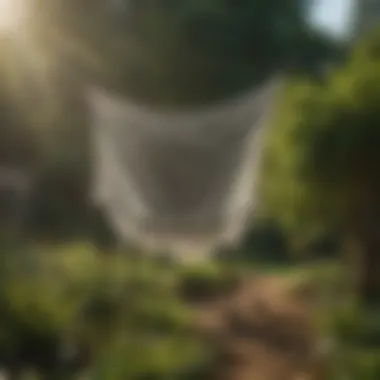
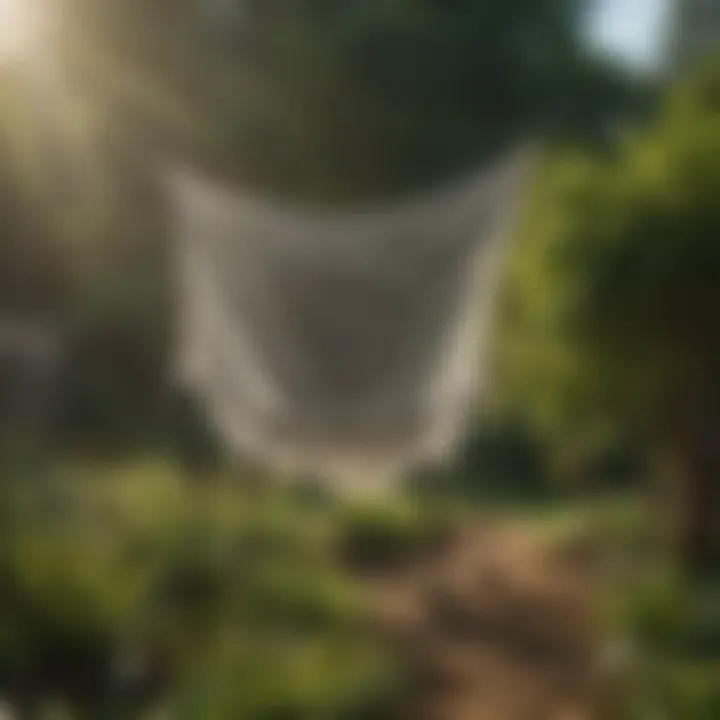
Gardening netting can be a valuable tool for protecting plants, but it is not without its challenges. Understanding these common issues can help gardeners take proactive steps to mitigate difficulties. Addressing problems such as animal access, netting degradation, and temperature regulation can ensure better plant health and improved crop yields.
Animal Access
One of the main challenges gardeners face is preventing animals from accessing their plants. Various creatures, like rabbits, squirrels, and birds, can easily breach netting. To effectively manage animal access, consider the following strategies:
- Choose the Right Type of Netting: Use bird netting, which is specifically designed with smaller openings to keep birds at bay while also deterring small rodents.
- Secure All Edges: Ensure the net is tightly secured around the garden beds to prevent animals from burrowing underneath. This may require stakes or weights.
- Install Higher Barriers: In addition to netting, consider incorporating physical barriers like fencing, especially for larger animals.
"A well-implemented netting strategy can significantly reduce plant damage from animal intrusion, enhancing the overall health of your garden."
Netting Degradation
Over time, gardening netting can suffer from environmental stressors. UV exposure, wind, and rain can cause materials to weaken, leading to holes or tears. To combat degradation, gardeners should:
- Select UV Resistant Materials: When choosing netting, look for products treated for UV protection to prolong their lifespan.
- Perform Regular Inspections: Schedule periodic checks for signs of wear and tear, allowing for repair or replacement before serious damage occurs.
- Store Properly During Off-Season: Protect netting from harsh winter conditions by storing it in a dry, shaded area. This can greatly extend its useful life.
Temperature Regulation
Netting can also impact the microclimate of a garden, influencing temperature and humidity levels around plants. Correct management of this aspect is crucial. Here are some recommendations:
- Choose Appropriate Mesh Sizes: Different mesh sizes can either retain more heat or allow for better airflow. It's vital to select netting based on the specific climate conditions and type of plants you are cultivating.
- Use Shade Netting Wisely: In hotter climates, shade netting can mitigate extreme temperatures and prevent plant stress during peak hours of sunlight.
- Monitor Conditions Regularly: Keep an eye on your plants and the surrounding environment to understand how netting affects temperature changes, adjusting as necessary.
By focusing on these common challenges, gardeners can optimize the use of netting. This not only enhances plant protection but also supports healthier growth and better productivity. These strategies are essential for any gardening enthusiast aiming for a thriving garden.
Innovative Applications of Gardening Netting
Gardening netting finds its relevance in many modern applications, especially in enhancing plant growth and maximizing space. These innovative uses open up possibilities for gardeners and farmers looking to optimize their yields while maintaining plant health. This section explores two significant applications: Vertical Gardening and Hydroponic Systems, highlighting their unique benefits and considerations.
Vertical Gardening
Vertical gardening involves growing plants upward rather than outward. This technique is particularly useful for urban gardeners with limited space. Gardening netting serves as a vital component in these systems, providing structural support for climbing plants. It enables plants like beans, peas, and even tomatoes to latch onto the netting, promoting airflow and light penetration. This not only maximizes growth but also minimizes the risk of pests that often thrive in crowded, low-growth areas.
Benefits of Vertical Gardening with Netting:
- Space Efficiency: Utilizing vertical space allows for a greater number of plants per square foot.
- Improved Aesthetics: Vertical gardens can create visually appealing green walls.
- Ease of Harvesting: Elevated plants are easier to access and maintain, reducing bending and awkward reaches.
- Enhanced Light Exposure: Positioning plants in a vertical arrangement increases their exposure to sunlight, supporting better growth.
Gardening netting must be durable and UV resistant to withstand outdoor conditions. Certain materials, such as nylon or polyethylene, work well due to their strength and longevity. The installation process is straightforward and requires proper planning to ensure the netting is taut and secure. Moreover, incorporating irrigation systems alongside netting can enhance the efficacy of vertical gardening, reducing water usage while ensuring plant hydration.
Hydroponic Systems
Hydroponics is another innovative application of gardening netting that has gained popularity in recent years. This method allows plants to grow without soil, using nutrient-rich water instead. Gardening netting can support plants in hydroponic setups by providing stability for roots while allowing water and nutrients to flow freely.
Considerations for Hydroponic Systems with Netting:
- Material Compatibility: The netting used must be conducive to the growth medium, often made from inert materials that won't impede growth.
- Water Management: Proper netting ensures adequate drainage and prevents waterlogging, which can harm plant roots.
- Light Availability: When integrating netting, consider the arrangement to ensure plants receive sufficient light.
Choosing the right type of netting is essential. For instance, plastic mesh netting works well for small plants, while sturdier options may be required for larger crops. As hydroponic systems often operate indoors or in greenhouses, the netting should also feature properties that promote airflow and temperature control.
"The use of netting in innovative gardening techniques expands the potential for plant cultivation and can lead to more productive and sustainable practices."
End
The topic of gardening netting is crucial in the context of modern agriculture and gardening practices. This section encapsulates the significance of gardening netting and how it influences the effectiveness of various gardening strategies. The use of appropriate netting ensures not only protection of plants but also aids in management of environmental factors, which is essential for thriving gardens.
The primary elements of gardening netting discussed throughout the article demonstrate its multifaceted benefits. From providing a barrier against pests to offering support for plant growth and enhancing plant health during adverse weather conditions, gardening netting serves multiple functions. This versatility makes it a valuable tool for gardeners at all skill levels.
Key considerations arise when selecting and applying netting. Factors such as material, mesh size, and durability play a significant role in the netting's effectiveness. When installed correctly, it can drastically improve yields by preventing damage from animals and harmful weather, thus safeguarding farmer's investments in their crops.
"Choosing the right gardening netting is imperative for successful plant protection and optimizing growth potential."
In summary, understanding the various applications and benefits of gardening netting can significantly enhance gardening practices. It aligns with the goal of promoting plant health, sustainability, and productivity. As more individuals embrace gardening as a source of food or leisure, knowledge of gardening netting will prove to be invaluable, making it an important subject to comprehend for both enthusiasts and professional farmers alike.
Summary of Key Points
- Protection: Gardening netting offers crucial protection against animals and pests, safeguarding crop integrity.
- Weather defense: Specialized netting helps buffer plants from harsh weather conditions, improving their resilience.
- Plant Support: Offers structural support to climbing plants and can enhance growth mechanics.
- Effective Selection: Materials and mesh size must be carefully considered to match specific gardening needs.
- Maintenance: Regular care ensures longevity and effectiveness of the netting.
Final Thoughts on Gardening Netting
The insights shared in this article serve to equip readers with the necessary information to explore gardening netting further and successfully implement it in their own practices. By integrating this knowledge, gardeners can look forward to optimized growth and enhanced plant health in their endeavors.















